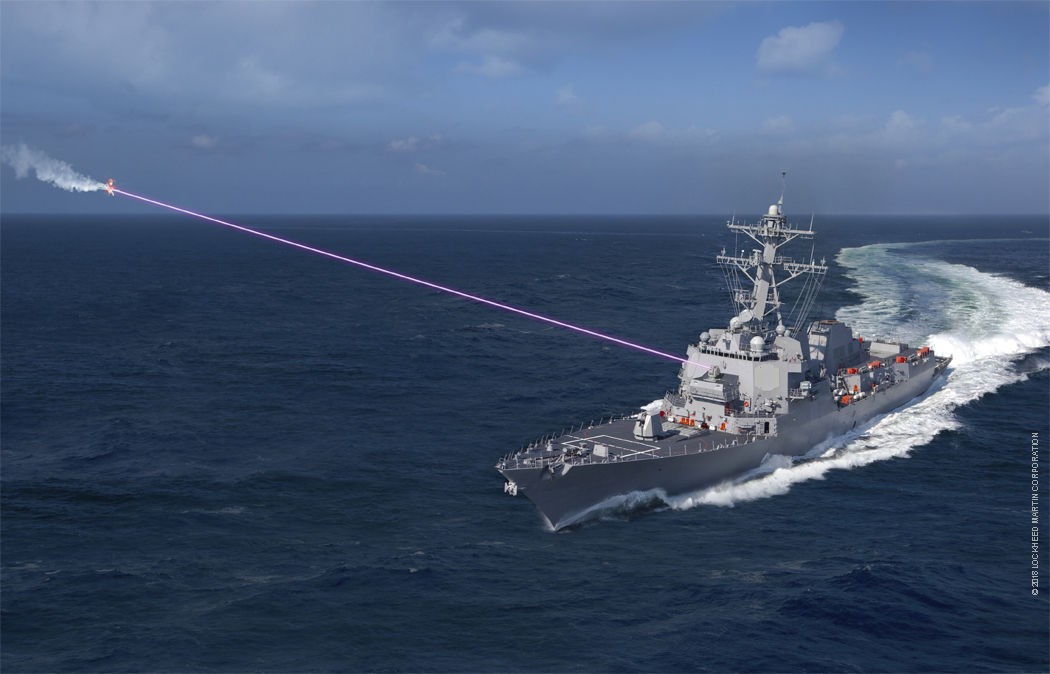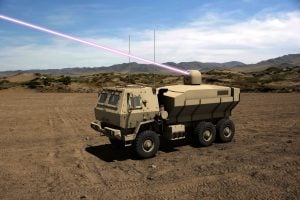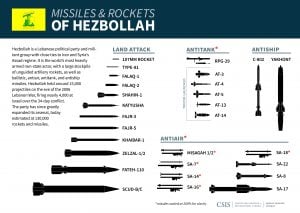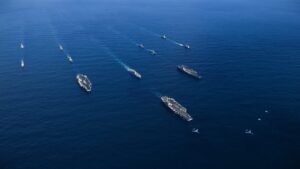
Lockheed Martin concept for their new HELIOS laser for the Navy. While HELIOS will primarily target drones, the next increment of the Navy’s laser program will take on cruise missiles.
AOC 2019: The Pentagon is pushing to double the power output of lasers, to over 300 kilowatts, so they can defeat a threat found in arsenals from the Russian army to the Chinese navy to Iran: cruise missiles.
“The current technology for laser sources is in that 100-150 kw class,” said Frank Peterkin, a senior scientist at the Office of Naval Research. “It’s not enough. Even if you take all the other elements of a laser weapon and have them be perfect” – the targeting, the cooling, the beam control — “we still don’t have enough power. It’s a common enough problem, it makes sense to [approach] it in a joint fashion,” Peterkin continued. “OSD’s Dr. Karr…. is leading a joint DoD-wide initiative to scale up power levels, because we all need more power.”

The original Dynetics/Lockheed concept for a 100 kW laser truck to kill drones and incoming rockets, artillery, & mortars. The Army is now pursuing a 250-300 kW weapon that could intercept cruise missiles.
As we’ve previously reported, former DARPA physicist Thomas Karr – the assistant director for directed energy under Pentagon R&D chief Mike Griffin – is leading an all-service effort to dramatically ramp up the power of laser weapons, with the Army looking to put the new technology on a truck for mobile cruise missile defense. What Navy and Air Force officials made clear today at the Association of Old Crows electronic warfare conference, however, is how eager their services are to kill cruise missiles as well.
The Air Force wants to put these future high-powered lasers on planes. “There’s great interest in … airborne capabilities for the counter-cruise missile [mission],” said Kelly Hammett, director of directed energy work at the Air Force Research Laboratory.
The Navy, which wants lasers on its ships, is probably the most enthusiastic of all. “The ability to take on cruise missiles — I’d say that is the predominant goal of the Navy’s current efforts …using lasers for ship defense against anti-ship cruise missiles,” Peterkin said.
But wait: Chinese nationalists and Sinophobes alike have hyped up the threat of China’s DF-21D “carrier-killer,” which is a ballistic missile. In fact, the whole US missile defense effort since the days of Reagan’s Star Wars program has focused on stopping ballistic missiles, whose parabolic flight paths through the upper atmosphere and outer space allow them to fly much faster and further than cruise missiles, whose whole flight path is in the atmosphere.
Precisely because cruise missiles fly through the air like planes, however they can maneuver much more unpredictably than ballistic missiles. That allows them to come in from unexpected angles and slip in under radar at low altitudes for surprise attacks. Historically, cruise missiles’ superior ability to steer also made them more precise, although cutting-edge (and expensive) ballistic missile warheads are becoming increasingly maneuverable as well.

Types of Hezbollah missiles (Graphic by Center for Security & International Studies)
All those factors make cruise missiles, not ballistic ones, the mainstay of anti-ship arsenals around the world. Even Lebanese Hezbollah managed to use one to cripple an Israeli corvette in 2006. Cruise missiles are also a major threat to fixed targets on land, like air bases, ports, and other infrastructure, as the Iranians proved with their recent crippling combo of cruise missiles and drones hitting Saudi oil fields.
The concern is not a single cruise missile, AFRL’s Hammett emphasized: “Scenarios [like] base defense, say, in the Pacific – it’s a large salvo or raid of missiles coming at you simultaneously, pretty similar to what happened in Saudi Arabia.”
Rather than set up your laser right next to what you’re defending, Hammett said, you could instead put it on an aircraft to intercept incoming cruise missiles much earlier in their flight path, when there’s more time to pick them off one by one. “If you sit at home plate and have 10 runners coming in simultaneously and you try to tag them all out, that’s not probably the winning solution,” Hammett said. “You want to get forward… with an airborne platform.”
Even so, shooting down that many targets fast enough will probably require some kind of artificial intelligence, Hammett went on, as well as laser weapons with enough precision and raw power to burn through each target quickly and move on to the next.
“We talk ad nauseam about power…because it’s the easiest, simplest metric,” Peterkin said. “It’s certainly necessary but not sufficient.
“We need to understand those targets better,” Peterkin continued, “because the advantage of a laser weapon is precision, and the disadvantage of a laser weapon is precision.” While a hit-to-kill missile like the modern Patriot will just crash into the target and smash it, a laser beam focuses precisely on a specific spot on the target and burns through. If you pick the wrong spot, you might not damage anything vital. If the spot you picked is tougher than your intelligence reports or your computer models said it was, you might not do enough damage in time.

Three nuclear-powered supercarriers — Reagan, Roosevelt, and Nimitz — and their escorts exercise together in the Pacific.
That’s a particularly acute problem with supersonic cruise missiles, whose nose cones are already reinforced to survive the heat of friction from their rapid progress through the air. That makes these kinds of cruise missiles largely immune to a laser shooting them from dead ahead. It’s much more effective for the laser to shoot the incoming cruise missile from the side, which in turn means the laser shouldn’t be positioned right on top of the target, but nearby – for example on an escorting warship.
That’s why the service envisions its Surface Navy Laser Weapon System evolving in three stages, Peterkin said:
- Increment 1 is the 60 kW HELIOS laser being installed on ships to destroy drones and cripple small attack craft;
- Increment 2 will ramp up the power enough to take side shots against cruise missiles, so a ship with it installed can use it to defend other ships nearby, but not itself; and
- Increment 3 will be still more powerful, able to burn through the nose-cone in a head-on shot, allowing a ship with it installed to defend itself.
Making these weapons work in the real world will require more power, sophisticated computer modeling, and extensive field testing, Peterkin cautioned. But the potential is there to shift the balance between missile offense and missile defense for future wars at sea.
Air Force picks Anduril, General Atomics for next round of CCA work
The two vendors emerged successful from an original pool of five and are expected to carry their drone designs through a prototyping phase that will build and test aircraft.


























